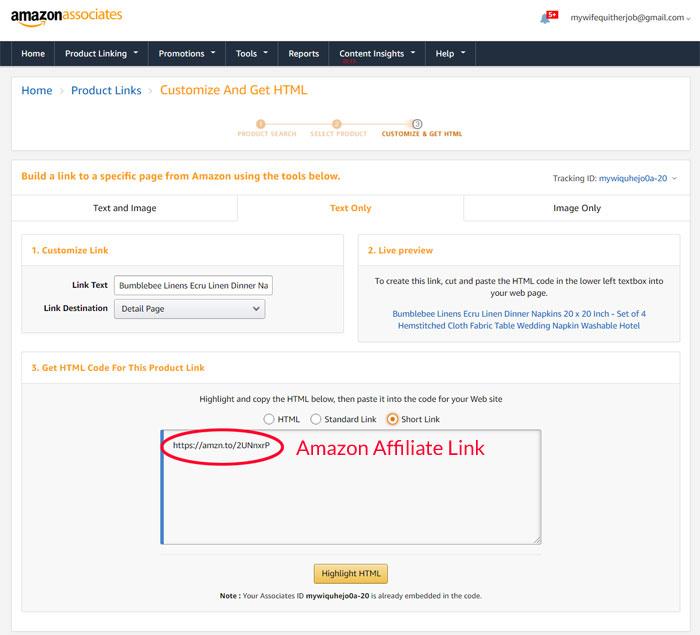Are you looking to turn your passion for blogging into a source of income? If so, you might want to consider joining the Amazon Affiliate Program! It’s a fantastic way to earn money by promoting products you love, and the best part is that integrating affiliate links into your WordPress site is easier than you might think. In this beginner’s guide, we’ll walk you through the simple steps to add Amazon affiliate links to your WordPress posts and pages, enabling you to start earning commissions in no time. Whether you’re a seasoned blogger or just starting, this guide will empower you to maximize your content’s potential and turn your website into a money-making machine. So, grab a cup of coffee, and let’s dive into the world of affiliate marketing together!
Understanding the Amazon Affiliate Program and Its Benefits
The Amazon Affiliate Program is one of the most popular and trusted affiliate marketing platforms available today. By joining this program, you can earn commissions by promoting products that you love and believe in. Whether you have a personal blog, a niche website, or an active social media presence, this program offers a fantastic opportunity to monetize your content.
One of the primary benefits of the Amazon Affiliate Program is its vast product selection. With millions of items available, you can easily find products that align with your audience’s interests. This diversity allows you to:
- Target specific niches: Whether it’s tech gadgets, home goods, or fashion, there’s something for everyone.
- Increase conversion rates: With an extensive inventory, you’re more likely to find products that resonate with your visitors.
- Leverage Amazon’s credibility: People trust Amazon, which can lead to higher sales through your affiliate links.
Another significant advantage of the program is the reliable payment structure. Amazon pays their affiliates a commission on every sale generated through your link, which can range from 1% to 10% or more, depending on the product category. Plus, you benefit from:
| Commission Rate | Product Category |
|---|---|
| 1% – 10% | Various Categories |
| Up to 10% | Luxury Beauty |
| 5% – 8% | Home & Garden |
| 3% – 5% | Books |
the tools and resources provided by Amazon make it easy to integrate affiliate links into your WordPress site. With user-friendly dashboards, link generators, and reporting features, you can track your performance effectively and make data-driven decisions to optimize your strategy. The program also supports:
- Multiple link types: Choose from text links, image links, or even a combination of both.
- Customizable banners: Use eye-catching visuals that fit seamlessly into your site’s design.
- Regular updates: Stay informed about new products and promotions to keep your content fresh and engaging.
By harnessing the potential of the Amazon Affiliate Program, you can not only enhance your website’s monetization but also provide valuable recommendations to your audience, creating a win-win situation for both you and your visitors.

Setting Up Your Amazon Affiliate Account Made Easy
Setting up your Amazon Affiliate account is a straightforward process that can open up a world of monetization possibilities for your WordPress site. First, you need to visit the Amazon Associates homepage and click on the “Join Now for Free” button. Fill in your account details, including your name, address, and website information. Make sure to provide accurate data, as Amazon will review your application based on this information.
Once your basic account is set up, it’s time to create your unique Associate ID. This ID is essential as it tracks the sales generated from your links. You can choose a name that reflects your niche, making it easier for you to manage and recognize your links later. After that, Amazon will ask for a brief description of how you intend to promote their products. You can mention your blog niche or the audience you aim to reach.
After your application is submitted, you’ll receive an email confirming your registration. However, keep in mind that your account will be in a temporary status until you make your first sale. This means it’s time to start adding Amazon products to your site. To do this effectively, consider the following tips:
- Choose Relevant Products: Focus on items that align with your niche to attract your audience.
- Utilize Amazon’s Tools: Explore the SiteStripe feature for easy link generation right from the product page.
- Craft Engaging Content: Write product reviews, how-to guides, or listicles incorporating your affiliate links naturally.
With your account set up and a strategy in place, adding affiliate links to your WordPress site becomes a breeze. Most commonly, you’ll use plugins like ThirstyAffiliates or Pretty Links to manage and cloak your links efficiently. Both plugins allow you to track clicks and optimize your links, ensuring you maximize your earning potential.
| Plugin | Features | Best For |
|---|---|---|
| ThirstyAffiliates | Link management, click tracking, link cloaking | Link optimization |
| Pretty Links | Link shortening, tracking, easy sharing | Simple link management |
After installing your preferred plugin, you can start creating and inserting your affiliate links into posts. Simply select the product you want to promote, generate your link, and paste it into your content. Don’t forget to add a compelling call to action to encourage your readers to click through and make a purchase. By following these steps, you’ll not only set up your Amazon Affiliate account with ease but also set the stage for successful monetization of your WordPress site.

Choosing the Right Products to Promote on Your Blog
When it comes to monetizing your blog with Amazon affiliate links, selecting the right products to promote is crucial for maximizing your earnings. It’s not just about choosing popular items; you need to consider your audience’s interests and the relevance of the products to your blog’s niche. Here’s what to keep in mind:
- Know Your Audience: Understanding your readers’ preferences can significantly influence the products you choose. Conduct surveys or analyze your blog’s analytics to gain insights into what your audience is most interested in.
- Align with Your Niche: Ensure that the products you promote are closely related to your blog’s theme. For instance, if you run a tech blog, focus on gadgets or software that your readers would find valuable.
- Consider Product Ratings: High-rated products tend to perform better. Check product reviews and ratings on Amazon before promoting them to ensure you’re recommending quality items.
Another strategy is to look for products that offer higher commissions. While you don’t want to sacrifice quality for a larger payout, finding items that balance both can boost your affiliate earnings. Here’s a simple table showcasing a few categories along with their potential commission rates:
| Product Category | Average Commission Rate |
|---|---|
| Electronics | 3% – 4% |
| Home & Kitchen | 4% – 8% |
| Fashion | 5% – 10% |
| Books | 4% – 10% |
Don’t overlook seasonal trends and special promotions as well. Certain products may sell better during holidays or specific events throughout the year. Keep an eye on Amazon’s deals and seasonal offerings to capitalize on these opportunities. Additionally, creating targeted content around these products can elevate your affiliate marketing game. For example, writing a gift guide during the holiday season can lead to increased clicks on your affiliate links.
Lastly, remember to test and optimize your approach. Monitor which products drive the most traffic and conversions. Use A/B testing for your links or product placements to see what resonates best with your audience. The more you refine your strategy, the better your results will be! By carefully selecting and promoting the right products, you can create a rewarding affiliate marketing experience for both you and your readers.
Getting Familiar with WordPress: A Quick Overview
Adding Amazon affiliate links to your WordPress site is a fantastic way to monetize your blog and earn some extra income. Whether you’re posting reviews, recommendations, or simply sharing products you love, affiliate links can seamlessly integrate into your content. To get started, here’s what you need to know.
First, sign up for the Amazon Affiliate Program. This is your gateway to gaining access to thousands of products. Once you’re approved, you’ll receive a unique affiliate ID. This ID is essential as it tracks your sales and earns you commissions. Here’s a simple process to follow:
- Visit the Amazon Associates website and create an account.
- Fill in your profile and details about your website.
- Once approved, navigate to the “Product Links” section.
Next up, create your affiliate links. Amazon makes this straightforward. Simply search for the product you want to promote, and once you find it, use the “Get Link” button to generate your affiliate link. You can choose between different formats, including text, images, or a combination of both. Here’s how you can embed them into your WordPress posts:
When you write your post, switch to the HTML editor, and paste your link directly where you want it to appear. For example:
AFFILIATELINK">Check out this amazing product!Another great option is to use WordPress plugins designed for affiliate marketing. These plugins can help manage your links effectively and make tracking easier. Here are a few popular ones:
- ThirstyAffiliates: A robust link management tool.
- Pretty Links: Shortens and beautifies your affiliate links.
- EasyAzon: Integrates directly with Amazon to streamline link creation.
remember to disclose your affiliate relationships. It’s not only ethical but also required by law. A simple note at the beginning or end of your post can build trust with your readers. Consider this example:
*This post contains affiliate links. If you purchase through these links, I may earn a small commission at no additional cost to you.
By following these steps, you’ll not only enhance your content but also potentially boost your earnings through affiliate marketing. Happy linking!

Installing Essential Plugins for Seamless Link Integration
To effectively integrate Amazon affiliate links into your WordPress site, utilizing the right plugins is essential for streamlining the process. These tools not only enhance functionality but also improve your user experience, making it easier to manage and display your affiliate links. Here are some must-have plugins to consider:
- ThirstyAffiliates: This powerful link management tool allows you to cloak your affiliate links, making them more visually appealing and easier to share. It also provides tracking features to monitor performance.
- EasyAzon: This plugin simplifies the process of adding Amazon affiliate links directly from your WordPress dashboard. With features like link localization and automatic image insertion, it’s perfect for beginners.
- Pretty Links: Another excellent link management plugin, Pretty Links helps you create clean, user-friendly URLs. Its tracking capabilities enable you to see which links perform best.
Alongside these plugins, consider integrating a few additional features that can optimize your affiliate marketing strategy:
| Feature | Benefits |
|---|---|
| Link Shortening | Reduces clutter in your posts and makes links more shareable. |
| Analytics Dashboard | Provides insights into link clicks, helping you refine your approach. |
| Geo-Targeting | Directs users to the appropriate Amazon site based on their location, maximizing conversions. |
Don’t overlook the importance of optimizing your content with these plugins. They’ll not only save you time but will also help enhance your site’s credibility and professionalism. As you implement these tools, remember to keep your audience in mind; provide valuable content that seamlessly integrates your affiliate products. Engaging visuals, compelling copy, and strategic placements of your links can greatly increase your chances of earning commissions.
By taking the time to install and configure these essential plugins, you’ll set yourself up for a more efficient and profitable affiliate marketing journey. Each tool complements your strategy by making it easier to manage links, track performance, and ultimately drive sales. So, equip your WordPress site with these powerful resources and watch as your affiliate efforts flourish.

Creating Compelling Content that Encourages Clicks
When it comes to driving traffic through your blog, the art of crafting clickable content cannot be overstated. Start by using an engaging, attention-grabbing headline that piques curiosity. Instead of a dry title, consider using a question or a bold statement that entices readers to learn more. This sets the stage for your audience to dive deeper into the article.
Another effective strategy is to incorporate rich media such as images, videos, or infographics that complement your text. These elements not only break up the monotony of text but also enhance the reader’s experience. For instance, showcasing a product image next to your affiliate link can create a visual connection that nudges your audience toward making a purchase.
Don’t forget about the power of call-to-action (CTA) phrases. Words matter, and using phrases like “Discover the best deals on Amazon” or “Grab yours before they’re gone!” can create a sense of urgency. Place these CTAs strategically within your content—either at the start, middle, or end—to maximize their effectiveness.
Here’s a simple table showcasing different CTA examples and their intended effects:
| Call to Action | Intended Effect |
|---|---|
| Shop Now | Immediate action |
| Learn More | Encourage further exploration |
| Limited Time Offer! | Create urgency |
| Exclusive Discount | Attract interest |
Lastly, never underestimate the significance of SEO optimization. Use keywords strategically throughout your content to ensure it ranks well on search engines. Not only will this help drive organic traffic to your site, but it will also make your content more discoverable, leading to higher chances of clicks on your affiliate links.
Adding Affiliate Links to Your Posts Effortlessly
Integrating affiliate links into your WordPress posts can significantly boost your income while providing value to your audience. Here’s how you can seamlessly add Amazon affiliate links without disrupting your writing flow.
First things first, you’ll need to sign up for the Amazon Associates program if you haven’t already. Once you’re approved, you can start generating affiliate links for any product. Here’s a quick step-by-step:
- Log in to your Amazon Associates account.
- Search for the product you want to promote.
- Click on “Get Link” to generate your unique affiliate link.
- Copy the link to use in your post.
Now that you have your affiliate link, let’s move on to adding it to your WordPress post. You have a couple of options to make this process smoother:
- Manual Insertion: Simply paste the affiliate link directly into your content where it feels natural. Make sure to use anchor text that describes the product to improve SEO and user experience.
- Using a Plugin: Consider using affiliate link management plugins such as Pretty Links or ThirstyAffiliates. These tools allow you to manage and cloak your links, making them cleaner and more user-friendly.
| Method | Pros | Cons |
|---|---|---|
| Manual Insertion | Simple and quick | Can become messy if overused |
| Using a Plugin | Organized and manageable | Requires a setup time |
After adding your affiliate links, don’t forget to track their performance. Amazon provides a robust reporting system that allows you to see which links are generating clicks and conversions. This insight is invaluable for refining your content strategy and focusing on what resonates with your audience.
Lastly, transparency is key. Always disclose your affiliate relationships within your posts. A simple note stating that you earn a commission on purchases made through your links builds trust with your readers and keeps you compliant with legal guidelines.

Optimizing Your Links for Maximum Visibility
When it comes to driving traffic and boosting conversions through your Amazon affiliate links, visibility is key. To ensure your links are seen and clicked, there are several strategies you can implement. First and foremost, context is everything. Placing your links within relevant content not only enhances user experience but also improves the likelihood of clicks. Make sure your affiliate links are embedded naturally in your text, so they provide value and context to your readers.
Another effective tactic is to utilize call-to-action (CTA) buttons. Rather than just pasting a plain link, consider creating visually appealing buttons that prompt action. Use contrasting colors and clear text on your buttons, such as:
- “Shop Now”
- “Check It Out”
- “See the Deals”
These buttons can enhance click-through rates and guide your readers towards making a purchase. Additionally, consider implementing hover effects to make your buttons more engaging. This simple interaction can draw more attention and encourage users to click.
Furthermore, link placement plays a crucial role in visibility. Here are some strategic locations to consider:
| Location | Benefit |
|---|---|
| Within introductory paragraphs | Captures attention early |
| At the end of blog posts | Appeals to readers ready to act |
| In sidebars | Consistent visibility on all pages |
| In promotional banners | Eye-catching and noticeable |
don’t underestimate the power of SEO optimization. Optimize your anchor text to be descriptive and relevant, which not only helps with search engine rankings but also gives your audience a clear idea of what to expect when they click the link. Aim to include keywords while keeping your text natural and inviting.

Tracking Performance and Making Data-Driven Decisions
Tracking the performance of your Amazon affiliate links is crucial for maximizing your earnings and ensuring your efforts yield fruitful results. By leveraging analytical tools, you can gain insights into how your links are performing, which products are resonating with your audience, and how to optimize your strategies moving forward.
Start by utilizing the Amazon Associates Central dashboard, where you can monitor key metrics such as:
- Clicks: The number of times users clicked on your affiliate links.
- Conversions: The percentage of clicks that resulted in a purchase.
- Earnings: How much you’ve earned from your affiliate sales.
In addition to Amazon’s built-in metrics, consider integrating analytics tools such as Google Analytics. Setting up goals specifically for your affiliate links can provide deeper insights. You can track:
- Traffic sources to see where your clicks are coming from.
- User behavior on your site, helping you identify the most effective content.
- Conversion rates over time, allowing you to spot trends.
Here’s a simple comparison of the two tools:
| Feature | Amazon Associates Central | Google Analytics |
|---|---|---|
| Affiliate Link Tracking | Yes | Limited (requires setup) |
| Traffic Source Analysis | No | Yes |
| User Behavior Insights | No | Yes |
| Real-time Data | Yes | Yes |
Utilizing both tools together can provide a comprehensive view of your performance. As you collect and analyze data, make data-driven decisions. For instance, if you notice that certain products consistently perform well, consider creating more content around those items. Conversely, if particular links underperform, don’t hesitate to revise your approach or replace them with more engaging alternatives.
the key to success lies in your ability to adapt and refine your strategies based on real insights. By consistently monitoring performance and making informed decisions, you’ll not only enhance your affiliate marketing efforts but also provide more value to your audience.
Tips for Staying Compliant with Amazon’s Affiliate Policies
To successfully navigate the world of Amazon’s affiliate program, it’s crucial to understand and adhere to their policies. Falling afoul of these guidelines can not only hinder your success but may also result in account termination. Here are some essential tips to keep you compliant:
- Read the Policies Thoroughly: Before you start, take the time to read Amazon’s Affiliate Operating Agreement and Program Policies. Familiarizing yourself with these documents will ensure you know what’s expected of you as an affiliate.
- Disclose Your Affiliation: Transparency is key. Always inform your audience that you may earn a commission on purchases made through your links. This builds trust and keeps you in line with FTC regulations.
- Avoid Inappropriate Content: Ensure that your website or blog content is professional and adheres to Amazon’s content guidelines. Avoid promoting products in a way that may be deemed misleading or inappropriate.
- Use Approved Links: Only use the links provided in your Amazon Associates account. Generating your own links or altering the links can lead to penalties.
Regularly review your affiliate status and performance metrics within the Amazon dashboard. Keeping track of which links perform well can help you refine your strategy while ensuring you’re still compliant with Amazon’s rules. This dashboard will often provide insights into your traffic sources, allowing you to optimize your content accordingly.
Consider creating an Affiliate Disclosure Page on your website. This page can detail how you utilize affiliate links and your commitment to transparency. Not only does this enhance your credibility, but it also aligns with best practices in affiliate marketing.
| Tip | Description |
|---|---|
| Read Policies | Familiarize yourself with Amazon’s guidelines. |
| Disclosures | Inform users about your affiliate relationships. |
| Use Approved Links | Only use Amazon-generated links for products. |
| Monitor Performance | Regularly check your affiliate dashboard for metrics. |
By following these guidelines, you can build a sustainable and compliant affiliate marketing strategy that not only protects your account but also enhances your reputation with your audience. Keep your content informative, engaging, and honest, and you’ll find success in your Amazon affiliate journey.
Frequently Asked Questions (FAQ)
How to Add Amazon Affiliate Links to WordPress? (Beginner’s Guide)
Q&A
Q1: What is Amazon Affiliate Program, and why should I join it?
A1: The Amazon Affiliate Program is a fantastic way to earn money by promoting Amazon products. When you join, you can create custom links to products or recommend items in your blog posts. Every time someone clicks your link and makes a purchase, you earn a commission! This is a simple yet powerful way to monetize your WordPress site, especially if you already create content around products or recommendations. Plus, Amazon has a trusted reputation, making it easier for your audience to feel comfortable clicking those links.
Q2: How do I join the Amazon Affiliate Program?
A2: Joining the Amazon Affiliate Program is super easy! Simply go to the Amazon Associates website, sign up for an account, and fill out the necessary information. They’ll ask for details about your website and how you plan to promote products. Once you’re approved, you can start creating affiliate links right away. Just make sure to adhere to their guidelines to keep your account in good standing!
Q3: What are the different ways to add Amazon affiliate links to my WordPress site?
A3: Great question! There are a few methods you can use to add affiliate links to your WordPress site:
- Manual Links: You can manually create links using the Amazon Associates SiteStripe tool. Just find the product on Amazon, click on the “Get Link” option, and copy the HTML code. Then, paste it into your WordPress editor.
- Plugins: Using a plugin like ThirstyAffiliates or Pretty Links can streamline the process. These plugins allow you to manage your affiliate links, track clicks, and even cloak them for cleaner URLs.
- Widgets: If you want to showcase products in your sidebar or footer, you can use the Amazon Product Advertising API or a dedicated widget plugin to display products dynamically.
Each method has its benefits, so choose what feels right for you!
Q4: Is there a preferred method for beginners to add affiliate links?
A4: Absolutely! For beginners, using a plugin is often the easiest route. Plugins simplify the process of adding, managing, and tracking your affiliate links without needing to dive into HTML. Plus, many plugins offer features like link shortening and click tracking, which can be incredibly helpful as you start.
Q5: Can I add Amazon affiliate links to different types of content, like blog posts or reviews?
A5: Yes, you can add affiliate links to a variety of content types! Blog posts, product reviews, comparison articles, and even social media posts are all excellent places to include these links. Just make sure the links are relevant to your content and provide real value to your readers. Authenticity is key, so share your genuine thoughts about the products!
Q6: How can I ensure my audience trusts my affiliate links?
A6: Building trust with your audience is crucial. Here are a few tips:
- Be Transparent: Always disclose your affiliate relationships. You can add a simple note at the top or bottom of your post, letting readers know you may earn a commission if they purchase through your links.
- Provide Value: Only recommend products you truly believe in and think will benefit your readers. Authentic recommendations build your credibility.
- Engage with Your Audience: Respond to comments and questions. The more you engage, the more your audience will see you as a trusted source.
Q7: What if I face issues while adding affiliate links?
A7: No worries! If you run into any issues, first check the Amazon Associates documentation as it’s filled with helpful guides. You can also seek advice from WordPress forums or communities, where fellow bloggers can share their experiences and solutions. Remember, every expert was once a beginner!
Q8: Are there any best practices I should follow when using affiliate links?
A8: Yes! Here are some best practices to keep in mind:
- Limit the Number of Links: Don’t overwhelm your readers with too many affiliate links. Focus on a few high-quality recommendations.
- Use Contextual Links: Incorporate links naturally within your content. This approach feels less salesy and enhances the user experience.
- Monitor Performance: Use the tracking features from your plugins or Amazon to see which links perform best, and adjust your strategy as needed.
By following these best practices, you’ll create a pleasant experience for your readers while increasing your chances of earning commissions!
Final Thoughts
By adding Amazon affiliate links to your WordPress site, you open up a world of monetization possibilities. Follow these steps, stay genuine with your recommendations, and watch your efforts pay off. Happy blogging, and may your affiliate journey be both rewarding and fun!
Closing Remarks
Conclusion
Congratulations! You’re now equipped with the essential knowledge to seamlessly integrate Amazon Affiliate links into your WordPress site. By following the steps outlined in this guide, you not only enhance your content but also unlock the potential to generate passive income through your passion for sharing valuable information.
Remember, the key to successful affiliate marketing lies in authenticity. Always prioritize your audience’s needs and recommend products that genuinely add value to their lives. As you continue to refine your approach, don’t hesitate to experiment with different placements and strategies to see what resonates best with your readers.
So, why wait? Dive in, start adding those affiliate links, and watch your efforts pay off! If you have any questions or need further assistance, feel free to reach out. Happy blogging, and here’s to your success in the exciting world of affiliate marketing!

